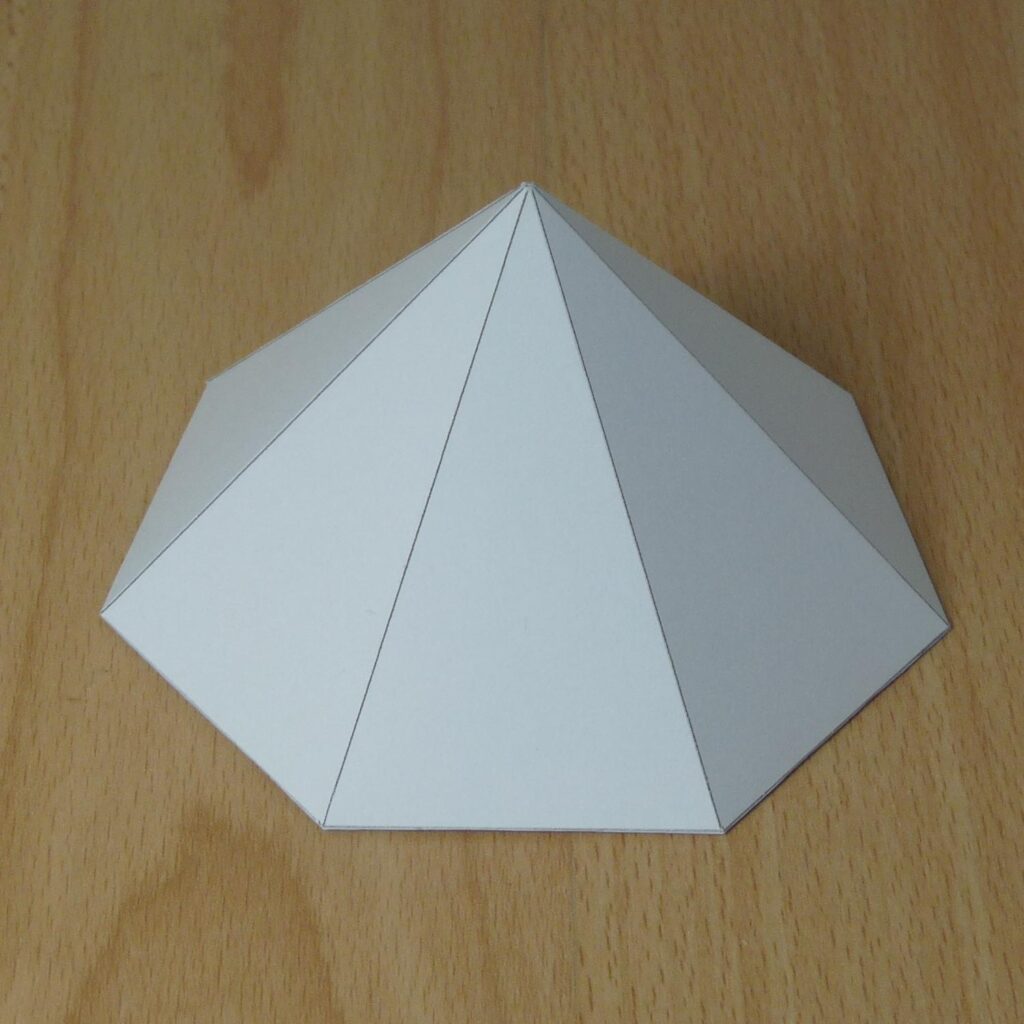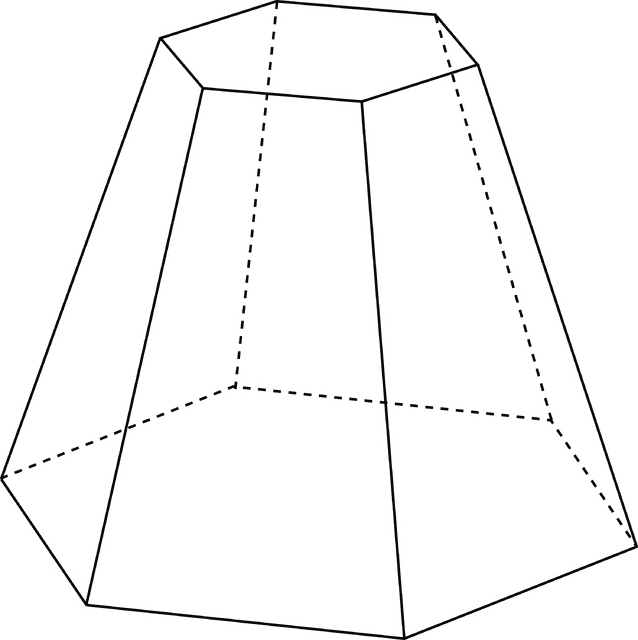Imagine you’re in math class, and the teacher starts talking about shapes. Most of the students are taking notes, but I found myself wondering about something specific: How many edges does a hexagonal pyramid have?
A hexagonal pyramid has a total of 12 edges. To understand this, imagine a three-dimensional shape with a hexagonal (six-sided) base and triangular sides coming up to meet at a single point on top.
Each of the six sides of the hexagonal base contributes one edge, and the six triangular sides each add one edge. So, 6 + 6 equals 12 edges in total.
These edges form the framework of the pyramid, helping to give it its distinctive shape. Counting them is essential when working with geometric calculations or building models.
So, whether you’re a student learning about shapes or just curious about hexagonal pyramids, knowing they have 12 edges is a fundamental piece of knowledge.
What is a Hexagonal Pyramid? Expanded

A hexagonal pyramid is a 3D shape, much like a classic pyramid, but with a distinctive twist. Its base is what sets it apart – it’s a six-sided shape known as a hexagon. That’s why it’s aptly called a “hexagonal” pyramid.
But what makes this pyramid truly fascinating is what happens as we move upwards from that hexagonal base. The six sides of the hexagon transform into triangles.
These triangular faces gradually incline and converge at a single point right above the center of the hexagon. This unique point where they meet is referred to as the “apex.”
The significance lies in the hexagon at the base, setting this pyramid apart from its pyramid counterparts, which often feature square bases. This hexagonal base not only gives it a distinct appearance but also unique mathematical properties.
A hexagonal pyramid consists of 6 isosceles triangular faces, each meeting at the apex. In total, it comprises 7 faces – one for each of the triangles and one for the hexagonal base.
Let’s talk numbers: A hexagonal pyramid boasts 7 faces, and it has 12 edges, which include 6 along the base and 6 connecting the triangular faces to the central point. Additionally, there are 7 vertices – 6 at the base and 1 at the apex.
So why is all this important or interesting? Well, beyond its geometrical elegance, hexagonal pyramids find utility in various fields. Architects incorporate them into designs, mathematicians find them intriguing subjects of study, and engineers apply their properties in construction.
What’s The Formula For Counting Edge
Counting the edges of a hexagonal pyramid can be made easier with a simple formula:
E = 6 + 2n
In this formula
- E stands for the total number of edges in the hexagonal pyramid.
- n represents the number of edges that meet at each vertex (corner) of the hexagonal base.
How This Formula Works
Base Edges (6): Start with the number 6. This part of the formula takes care of the edges that make up the hexagonal base. As we know, a hexagon has six sides, so there are six edges at the base of the pyramid.
Triangular Faces (2n): The “2n” part of the formula accounts for the edges formed by the triangular faces that connect the base to the apex.
To understand why it’s “2n,” consider that at each vertex of the hexagonal base, two edges extend upward to connect with the apex. This is where “2” comes from.
The “n” represents the number of vertices on the base. In a hexagon, there are six vertices. Therefore, “n” equals 3 because each vertex connects to three edges (two triangular faces and one base edge).
How To Calculate The Total Edges
Now, let’s put the formula to use
E = 6 + 2n
E = 6 + 2(3)
E = 6 + 6
E = 12
So, when we apply this formula to a hexagonal pyramid, we find that it has a total of 12 edges.
This formula simplifies the process of counting edges, especially in more complex situations involving different polygonal bases. It allows you to calculate the edge count systematically and accurately by considering the base edges and the edges formed by the triangular faces.
Remember, the formula E = 6 + 2n is a handy tool for geometry enthusiasts and anyone working with hexagonal pyramids.
How to Count Edges in a Hexagonal Pyramid
Firstly, begin by identifying the hexagonal base of the pyramid. This is the foundational shape at the very bottom of the pyramid. The base of a hexagonal pyramid, as the name suggests, is a hexagon, a polygon with six equal sides.
Each of these sides, or line segments, is considered an edge. So, you already have six edges right from the base.
Now, let’s focus on the triangular faces that connect the base to the apex of the pyramid. There are six of these triangular faces, and they play a crucial role in determining the total number of edges.
Each of these triangular faces has one edge that connects to the base and two more edges that meet at the apex (the top point of the pyramid). So, for each of the six triangular faces, you have two additional edges.
To calculate the edges contributed by these triangular faces, multiply the number of triangular faces (6) by the number of edges per face (2). This gives you a total of 12 edges for the triangular faces.
Finally, there’s one more edge to consider—the edge that extends from the apex (the top point) of the pyramid straight down to the center of the hexagonal base. This edge serves as the central “spine” of the pyramid, connecting the apex to the middle of the hexagon.
So, to summarize
- You have 6 edges from the base.
- You have 12 edges from the triangular faces.
- You have 1 edge extending from the apex to the center of the base.
When you add these up, you get a total of 6 base edges + 12 edges from the triangular faces + 1 apex edge, resulting in 19 edges in total for a hexagonal pyramid.
In short, this step-by-step breakdown should help you confidently count the edges of a hexagonal pyramid.
What Are the Common Mistakes When Counting Edges?

When it comes to understanding and working with hexagonal pyramids, there are a few common mistakes and pitfalls that individuals may encounter.
One of the most common errors is misidentifying the base of the hexagonal pyramid. Always ensure that you correctly recognize the hexagonal shape at the bottom as the base. Confusing it with another face can lead to inaccuracies when counting edges.
Another common mistake arises when counting the number of edges that meet at each vertex. In a hexagonal pyramid, it’s essential to remember that each vertex on the hexagonal base connects to three edges (two triangular faces and one base edge). Failing to consider this can lead to an incorrect edge count.
Also, some individuals may overlook the edge that extends from the apex to the center of the hexagonal base. It’s crucial to include this central edge when counting the total number of edges in a hexagonal pyramid.
Similarly, errors can occur when counting the edges of the triangular faces that connect the base to the apex. Be sure to recognize that each triangular face contributes two edges, not three, as might be mistakenly assumed.
However, Hexagonal pyramids can be confused with other pyramid shapes, especially if they have similar bases. Always double-check the base shape and triangular faces to ensure you are dealing with a hexagonal pyramid specifically.
Avoid the mistake of counting edges manually every time. Utilize the edge-counting formula (E = 6 + 2n) we discussed earlier to simplify the process and minimize the risk of calculation errors.
By being aware of these common mistakes and pitfalls, you can enhance your understanding of hexagonal pyramids and ensure accurate edge counting. Remember that practice and familiarity with the pyramid’s characteristics will lead to greater confidence in working with this fascinating geometric shape.
FAQ
Is a hexagonal prism has 12 vertices and 18 edges true?
Yes, that’s correct! A hexagonal prism indeed has 12 vertices and 18 edges. It’s a fascinating 3D shape with a hexagonal base and rectangular sides.
What prism has 8 vertices and 12 edges?
A triangular prism has 8 vertices and 12 edges. It’s formed with a triangular base and three rectangular faces.
What prism has 12 sides?
A dodecagonal prism has 12 sides. It’s a prism with a base that has 12 equal sides.
How many edges does a 12 sided prism have?
A prism with 12 sides, known as a dodecagonal prism, has 30 edges.
What prism has 21 edges?
A heptagonal prism has 21 edges. It features a seven-sided base and seven rectangular faces.
What prism has 15 edges?
A pentagonal prism has 15 edges. Its base has five sides, and it has five rectangular faces.
What prism has 33 edges?
A hendecagonal prism has 33 edges. It’s a prism with an eleven-sided base and eleven rectangular faces.
What prism has 60 edges?
An icosagonal prism has 60 edges. It’s a fascinating shape with a base featuring 20 sides and 20 rectangular faces.
What prism has 48 edges?
A tricontagonal prism has 48 edges. This prism has a base with 30 sides and 30 rectangular faces.
What 3D shape has 8 sides?
A cube is a 3D shape with 8 sides. It’s a familiar shape with all sides being equal squares.
What prism has 20 faces?
An icosahedral prism has 20 faces. It’s a unique prism with a base featuring 20 equilateral triangles.
Final words
To sum up, we now know that a hexagonal pyramid, which has a six-sided base and triangular faces meeting at a point on top, has a total of 12 edges. We’ve also learned a handy formula (E = 6 + 2n) to make counting edges easier.
But this isn’t just about math—it’s about exploring new ideas and using geometry in creative ways. Architects use these shapes in their designs, while mathematicians study them, and engineers apply them in building things.
So, whether you’re a student or just someone who loves learning, understanding hexagonal pyramids is like going on an exciting adventure. As you continue your journey into the world of shapes, remember that even complex things can have simple explanations.

